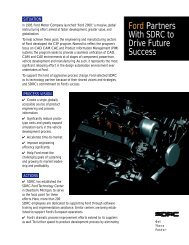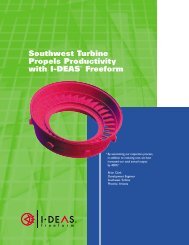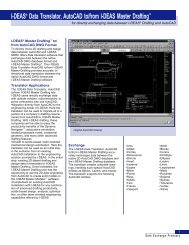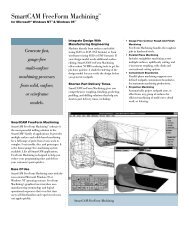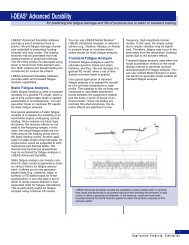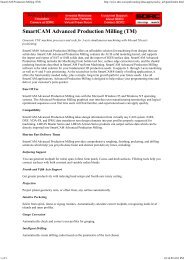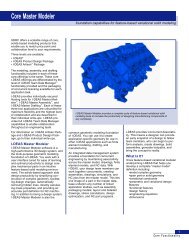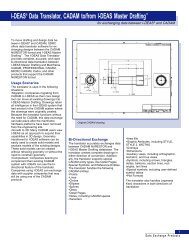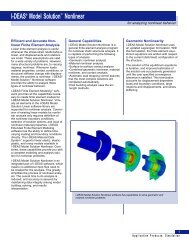I-DEAS® TMG Thermal Analysis
I-DEAS® TMG Thermal Analysis
I-DEAS® TMG Thermal Analysis
You also want an ePaper? Increase the reach of your titles
YUMPU automatically turns print PDFs into web optimized ePapers that Google loves.
Conduction<br />
I-DEAS <strong>TMG</strong> <strong>Thermal</strong> <strong>Analysis</strong> uses a<br />
conservative element-based control<br />
volume formulation to compute accurate<br />
conductive and capacitive terms for<br />
arbitrary, unstructured meshes. The<br />
proprietary scheme is based on an<br />
element temperature function constrained<br />
at calculation points on the<br />
boundaries and at the geometric centroid.<br />
The resulting solution matrix is<br />
extremely accurate, stable, and fully<br />
compatible with finite difference solvers<br />
such as SINDA. The approach also<br />
supports the direct insertion of usercalculated<br />
conductance terms and the<br />
manipulation of the solution matrix in<br />
user-supplied code.<br />
The software supports a wide variety of<br />
element types, including solids, shells,<br />
and beams, as well as axisymmetric<br />
elements. A unique multi-layer shell<br />
formulation is provided, for efficient<br />
modeling of laminates, honeycomb<br />
panels, and high performance insulation.<br />
Orthotropic and temperature dependent<br />
thermal conductivity is supported for all<br />
element types, as is phase change.<br />
I-DEAS <strong>TMG</strong> powerful thermal coupling technology makes it easy to create complex<br />
thermal assemblies containing many individually meshed parts. Element meshes do<br />
not need to match, saving considerable meshing time and simplifying your model.<br />
<strong>Thermal</strong> Couplings<br />
<strong>Thermal</strong> couplings provide a powerful<br />
and efficient capability for building assemblies<br />
by modeling heat flow between<br />
unconnected parts and components.<br />
Conductances are created between<br />
elements coated on the corresponding<br />
surfaces or edges. The couplings are<br />
established based on element proximity<br />
and are distributed to account for overlap<br />
and mismatch between disjoint or dissimilar<br />
meshes. Coupling types include<br />
conductive, radiative, convective, and<br />
interface.<br />
Boundary Conditions<br />
A wide range of load, restraints, and<br />
boundary conditions can be applied to an<br />
I-DEAS <strong>TMG</strong> thermal model, using either<br />
the standard I-DEAS capabilities or<br />
specialized I-DEAS <strong>TMG</strong> tools. Boundary<br />
conditions can be defined on nodes,<br />
elements, surfaces, or volumes; data<br />
applied to solid model geometry is fully<br />
associative, and automatically updated if<br />
the part and its associated mesh is<br />
changed. The capabilities include:<br />
•Fixed or initial temperatures<br />
•Heat loads and fluxes (surface or body)<br />
•Radiative and convective boundary<br />
conditions<br />
•Transient loads and restraints<br />
•Data surfaces for spatially-varying<br />
boundary conditions<br />
•Time-averaged heat loads<br />
•Thermostats with hysteresis<br />
•Import of external CFD data<br />
Coupled thermal/fluid<br />
You can accurately model the effects of<br />
forced and natural convection within<br />
conjugate heat transfer problems.<br />
I-DEAS <strong>TMG</strong> duct flow enables you to<br />
quickly and easily model one-dimensional<br />
networks, while the I-DEAS Electronic<br />
System Cooling package<br />
provides full CFD capabilities for simulating<br />
complex 3D flow systems. <strong>Thermal</strong><br />
Coupling tools enable you to couple flow<br />
models with an I-DEAS <strong>TMG</strong> model,<br />
even if the meshes are dissimilar, and to<br />
compute convective heat transfer coefficients<br />
based on the coupled solution.<br />
Joule Heating<br />
I-DEAS <strong>TMG</strong> can simulate the effects of<br />
Joule Heating. Current flow density is<br />
computed based on voltage boundary<br />
conditions and electrical resistivity. The<br />
electrical properties can vary with temperature,<br />
providing full coupling with the<br />
thermal model.<br />
Model Reduction<br />
Model simplification tools are available<br />
for simplifying or conditioning a thermal<br />
model matrix prior to solution. They<br />
include element deactivation, conductance<br />
thinning, element merging, and<br />
model substructuring.<br />
2<br />
Application Products: Simulation






